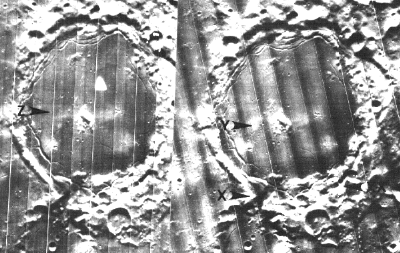
Jay Reynolds posed an interesting question:
From: freeman@netcom.com (Jay Reynolds Freeman)
Subject: Hesiodus ray reversed?
Date: Mon, 27 Jan 1997 03:16:01 GMT
Several of us have observed the Hesiodus sunrise ray -- a narrow band
of light that shines westward at lunar sunrise, out across the floor of
Hesiodus, from a gap in the common wall of Hesiodus and Pitatus.
Does it work both ways? Is there a Pitatus sunset ray, shining
eastward from the same gap across the floor of Pitatus? It would occur
somewhat past third quarter, hence would be well-placed for nighttime
viewing only rather late. But it might be fun to look for.
And then went on further to do some calculating as to when this even would be visible:
I have been trying to figure out when is the next time a Pitatus sunset ray might be visible. The Pitatus / Hesiodus boundary is at about 15 west Selenographic longitude, and one might reasonably expect the ray when the sunset terminator still lay somewhat east of that line. According to the RASC handbook, the selenographic colongitude of the Sun is 189.75 at 0 hours UT on February 1, which -- if I have got my signs and interpretations right -- means the sunset terminator is at 9.75 west. Four degrees more takes about another eight hours, so my guess is that the next favorable opportunity is on or slightly after 0800 UT February 1, 1997. But I wouldn't want you folks to go out in the cold winter air without somebody else checking my work. Will someone please do that? If I am right, that means that the phenomenon will occur on or slightly after moonrise here in California, so we might not see it very well, even if the weather clears. (Hah!) (That's shortly after midnight on the night between Friday, 31 January and Saturday, 1 February.) New-World observers further to the east will be better placed, but will have to stay up later. And, again assuming I have got the formulae right, the next time is about 22 hours UT on March 2, at which time the Moon is well below the horizon for North America.
I ran the calculations through the Lunar Tool Kit program, by Harry Jamieson, and came up with the following scenarios for an ephemeris:
Starting Date = 1998 / 1 / 1 U.T.
Site Longitude = 94.90 Latitude = 39.05 Elevation = 250 meters
Feature = PITATUS
Longitude = -13°30' Latitude = -29°48'
Reproducing Lighting For: 1997 / 11 / 23 at 8 : 47 UT
Desired Solar altitude = -0.006° (Setting), Azimuth = 271.735°
Average Co-longitude = 193.506
In the time column, D=daylight, T=twilight
---- Moon's ----
Topocentric -- Earth's -- ------- Sun's -------
UT Date Time Alt° Semi-diam" Long° Lat° Colong° Lat° Azim°
1998/ 1/21 14:27D 35.67 909.54 -4.55 -5.72 192.92 1.02 271.17
1998/ 4/20 9:31 16.22 957.51 -7.21 -3.52 194.20 -1.21 268.60
1998/ 6/18 8:42 17.95 977.78 -2.43 3.79 194.31 -1.41 268.38
1998/ 9/14 16: 8D 51.40 950.33 6.77 5.17 193.17 0.59 270.67
1998/11/12 17: 5D 35.11 911.03 6.55 -1.37 192.63 1.54 271.77